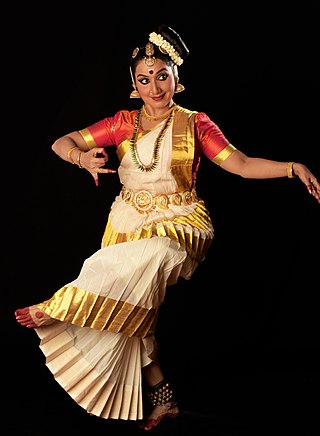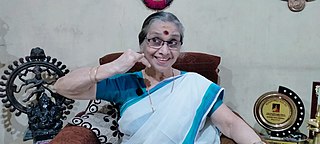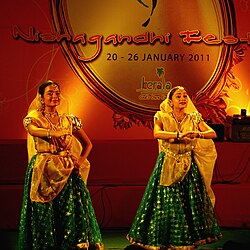
Kathakali is a major form of classical Indian dance. It is a "story game" genre of art, but one distinguished by the elaborately colourful make-up and costumes of the traditional male actor-dancers. It is native to the Malayalam-speaking southwestern region of Kerala and is almost entirely practiced and appreciated by Malayali people.

Indian classical dance, or Shastriya Nritya, is an umbrella term for different regionally-specific Indian classical dance traditions, rooted in predominantly Hindu musical theatre performance, the theory and practice of which can be traced to the Sanskrit text Natya Shastra. The number of Indian classical dance styles ranges from eight to twelve, or more, depending on the source and scholar; the main organisation for Indian arts preservation, the Sangeet Natak Academy, recognizes eight – Bharatanatyam, Kathak, Kuchipudi, Odissi, Kathakali, Sattriya, Manipuri and Mohiniyattam. Additionally, the Indian Ministry of Culture includes Chhau in its list, recognising nine total styles. Scholars such as Drid Williams add Chhau, Yakshagana and Bhagavata Mela to the list. Each dance tradition originates and comes from a different state and/or region of India; for example, Bharatanatyam is from Tamil Nadu in the south of India, Odissi is from the east coast state of Odisha, and Manipuri is from the northeastern state of Manipur. The music associated with these different dance performances consists many compositions in Hindi, Malayalam, Meitei (Manipuri), Sanskrit, Tamil, Odia, Telugu, and many other Indian-Subcontinent languages; they represent a unity of core ideas, and a diversity of styles, costumes and expression.

Dance in India comprises numerous styles of dances, generally classified as classical or folk. As with other aspects of Indian culture, different forms of dances originated in different parts of India, developed according to the local traditions and also imbibed elements from other parts of the country.
Perumanoor Gopinathan Pillai, more popularly known as Guru Gopinath was a well known actor-cum-dancer. He is well regarded as the greatest preserver of the dance tradition. He is a recipient of the Sangeet Natak Akademi Award, the Kerala Sangeetha Nataka Akademi Fellowship, and the Kerala Sangeetha Nataka Akademi Award.

Sitara Devi was an Indian dancer of the classical Kathak style of dancing, a singer, and an actress. She was the recipient of several awards and accolades, and performed at several prestigious venues in India and abroad; including the Royal Albert Hall, London (1967) and at the Carnegie Hall, New York (1976).

Sangeet Natak Akademi is the national level academy for performing arts set up by the Government of India.

Mrinalini Vikram Sarabhai was an Indian classical dancer, choreographer and instructor. She was the founder and director of the Darpana Academy of Performing Arts, an institute for imparting training in dance, drama, music and puppetry, in the city of Ahmedabad. She received Padma Bhushan in 1992 and Padma Shri in 1965. She also received many other citations in recognition of her contribution to art.

The city of Thiruvananthapuram has been the centre of cultural activities of Kerala (India) from the time it was made capital of Travancore in 1745. The capital city is a major intellectual and artistic center. The Thiruvananthapuram Museum and Thiruvananthapuram Zoo were started during the reign of Swathi Thirunal (1813–1847) and are one of the oldest of their kind in India. The city's libraries include the Trivandrum Public library, which was started in 1829. The Swathi Thirunal College of Music and 'College of fine arts' are the leading institutions related to music and arts.

Sunanda Nair is an Indian dancer trained in Mohiniattam. She did her master's degree in this dance form from Nalanda Nritya Kala Mahavidyalaya affiliated to the University of Mumbai. She has completed her PhD from University of Mumbai for her thesis "Intrinsic Lyrical Feminism in Mohiniattam". She was born in Mumbai, India.
Keezhpadam Kumaran Nair (1916–2007) was a Kathakali artists from Kerala, India. Endowed and equip with a life profile that also show him to several traditional Indian performing arts other than Kathakali, his stage presentation infused a fresh breath into the four-century-old art form, thanks also to his broad and deep view about the Puranas that spurred from a constant pursuit of knowledge through reading books and engaging in talks in scholars.

Nelliyode Vasudevan Namboodiri or Nelliyod Vasudevan Namboodiri was a Kathakali artiste, noted primarily for his vibrant portrayal of the evil chuvanna thaadi roles of the classical Kathakali dance-drama from Kerala in south India. He was also very famous and known for the characters 'Kuchelan' from Kuchelavritham and 'Aashaari' from Bakavadham.

Kanakakkunnu Palace is situated in Thiruvananthapuram near the Napier museum, India. It is India's first digital garden, created by Akhilesh S. V. Nair and A. Gangaprasad, University of Kerala, Department of Botany.

Gayathri Govind, is an Indian classical dancer, choreographer, actor and the winner of Asianet's Vodafone Thakadimi in 2008.
Shanta Rao was a notable dancer from India. She studied and performed Kathakali, Bharatanatyam and Kuchipudi.
Kalamandalam V. Satyabhama was an Indian classical dancer, teacher and choreographer, known for her performances and scholarship in mohiniyattam. She was awarded the Padma Shri, in 2014, for her contributions to the art and culture, by the Government of India.

Myriam Sophia Lakshmi Quinio, known professionally as Paris Laxmi is a dancer and actress born in France and settled in Kerala, India. With her husband Kathakali dancer Pallippuram Sunil, she runs the Kalashakti School of Arts in Vaikom, Kerala.

Neena Prasad is an Indian dancer. She is an exponent in the field of Mohiniyattam. She is the founder and principal of Bharthanjali Academy of Indian Dances in Thiruvananthapuram and Sougandika Centre for Mohinyattam in Chennai.

Kalamandalam Radhika is an Indian classical dancer, choreographer, research scholar, teacher, writer and philanthropist. She was the first non-resident Keralite to win the Kerala Sangeetha Nataka Akademi Award for Mohiniyattom. She learnt Kuchipudi, Bharatanatyam, Kathakali and other dance forms.

Chemancheri Kunhiraman Nair, also known as Guru Chemancheri was an Indian Kathakali actor. He spent over eighty years learning and teaching and performing Kathakali, a major form of classical Indian dance. The Government of India awarded him the fourth highest civilian honour, Padma Shri in 2017.

Kala Vijayan is an Indian classical dance performer, choreographer, author and actor. She is the daughter of the legendary Kathakali artist Kalamandalam Krishnan Nair and Mohiniyattam exponent Kalamandalam Kalyanikutty Amma. Kala Vijayan is trained in Mohiniyattam, Bharatanatyam and Kathakali, however she is best known for her contributions to Mohiniyattam. She is the recipient of Kerala Sangeetha Nataka Akademi Award for Mohiniyattam (1998) and the Kerala State Award for Mohiniyattam (2019). She is the Principal Director and senior Guru at Kerala Kalalayam, a fine arts institute established by her parents at Thripunithura in 1952.
















